The Drama of Nature
Turner
began his career as a precise recorder of picturesque places, but developed
into one of the great painters of the imagination, conjuring dramatic visions
from the full majesty of nature.
Turner
is generally considered to have been the most original genius of landscape
painting of the 19th century, though it would be true to say that by the end of
his life he had become a painter, not of land, sea and sky, but of light
itself. Certainly, no other painter matched the sheer brilliance of his
colours, and none used light to create such powerful and overwhelming images of
nature and its impact on human destiny.
A TASTE FOR THE PICTURESQUE
As a
young man, Turner was gifted with both a precocious talent and a strong sense
of ambition. Devoted from the first to landscape, he received some training in
topography (the detailed depiction of places) and soon became adept at drawing
ruined abbeys, crumbling castle walls, decaying villages and subjects favoured
by a fashionable taste for the 'picturesque'. Turner's visual memory was
extremely acute, and never forsook him, but his engravings and water-colours of
this early period were based, as were almost all his works, on the innumerable
sketches he always made on his journeys, whether to the Scottish Highlands or the
Swiss Alps. He was tirelessly energetic and got up in time to see the sun rise
whenever he could.
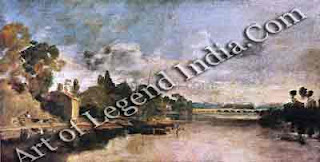 Once he
had taken up oils, he made a name for himself by adapting the style of other
famous landscape painters to the romantic style of his day. These versions of
such masters as Claude, Richard Wilson and Rembrandt were made in a spirit of
rivalry, rather than homage. Throughout, he freely indulged his preference for
the melodramatic and catastrophic. Whirlwinds, avalanches, storms at sea and
the destruction of great civilizations were his constant subjects.
Once he
had taken up oils, he made a name for himself by adapting the style of other
famous landscape painters to the romantic style of his day. These versions of
such masters as Claude, Richard Wilson and Rembrandt were made in a spirit of
rivalry, rather than homage. Throughout, he freely indulged his preference for
the melodramatic and catastrophic. Whirlwinds, avalanches, storms at sea and
the destruction of great civilizations were his constant subjects.
Due
entirely to his own neglect of them, many of Turner's oil paintings were badly
damaged during his lifetime, but fortunately his huge collection of sketches
was much better preserved. In 1806-7 he was painting oil sketches directly from
nature; as often as not, his subject was the Thames Valley, which he painted
while being rowed in a boat. Their vivid grasp of detail and atmosphere anticipates
Constable's equally celebrated sketches by almost ten years.
THE ROMANCE OF THE RIVER
Turner
associated London and the Thames with other great civilizations Venice, ancient
Rome and Carthage. In one of his Thames sketchbooks, Phoenician ships sweep
down the river at Twick-enham. Turner was fascinated by every kind of ship and
boat, and prided himself on his nautical knowledge. No sooner had HMS Victory
limped into port after the Battle of Trafalgar, than Turner was on board,
interviewing the crew and making numerous sketches.
Despite
his mastery of oils, Turner never lost his interest in water-colours, which he
used both as an aid to his memory in sketches and as a serious medium in its
own right. In fact, his technique in oils was indebted to his experiments in
water-colours, for he devised a way of floating a beautifully subtle film of
mother-of-pearl paint over his canvases, which gave them a unique delicacy.
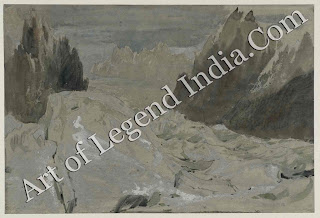 By
1805, Turner was applying paint boldly and freely, and later began to compose
his paintings around circular or winding shapes, allowing the eye to be drawn
into his receding whorls of colour. This proved especially effective when he
came to paint seascapes. Another typical feature is that Turner's viewpoint
nearly always looks directly into the sun. In his later masterpieces, the
immaterial vehicles of colour steam, smoke, mist, clouds and so on envelop the
forms, which are seen to merge, dissolve and lose themselves in the general
blaze of light. Indeed, in some of his most personal works, he dispensed with
form altogether, relying entirely on the power of colour.
By
1805, Turner was applying paint boldly and freely, and later began to compose
his paintings around circular or winding shapes, allowing the eye to be drawn
into his receding whorls of colour. This proved especially effective when he
came to paint seascapes. Another typical feature is that Turner's viewpoint
nearly always looks directly into the sun. In his later masterpieces, the
immaterial vehicles of colour steam, smoke, mist, clouds and so on envelop the
forms, which are seen to merge, dissolve and lose themselves in the general
blaze of light. Indeed, in some of his most personal works, he dispensed with
form altogether, relying entirely on the power of colour.
He
realized that one colour had a greater power than two, and two greater than
three. Colour now acquired an almost symbolic significance. Jotting down
colours in one of his sketchbooks, he wrote 'fire and blood' instead of 'red'.
VIEWS OF VENICE
Turner's
tendency towards abstraction did not by any means prevent him painting pictures
which, in their subject matter at least, were very particular. His picture
Snowstorm, painted in 1842, carried the subtitle Steamboat off a Harbour's
Mouth Making Signals in Shallow Water and Going by the Lead, which shows both
his love of circumstantial detail and pride in the painting's factual accuracy.
His views of Venice, especially those executed immediately after his visits,
are moving exactly because they combine strict architectural authenticity with
an almost magical luminosity of atmosphere. And, as the young lady who followed
Turner's example by sticking her head out of the train-carriage window was able
to confirm, Turner's observation of such phenomena as trains running through
storms (Rain, Steam and Speed) was also highly accurate.
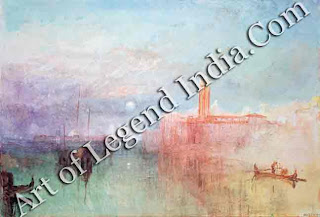 Turner's
avalanches and storms expressed his belief in the insignificance of man faced
with the overpowering and destructive force of nature, but at the same time his
radiant colours and light testify to nature's life-giving essence. It is the
tension between these two great contrary visions that made Turner the genius he
was. As Ruskin said of him: 'Here and there, once in a couple of centuries, one
man will rise past clearness and become dark with excess of light.'
Turner's
avalanches and storms expressed his belief in the insignificance of man faced
with the overpowering and destructive force of nature, but at the same time his
radiant colours and light testify to nature's life-giving essence. It is the
tension between these two great contrary visions that made Turner the genius he
was. As Ruskin said of him: 'Here and there, once in a couple of centuries, one
man will rise past clearness and become dark with excess of light.'
Vortex of the Storm
One
characteristic feature of Turner's painting is his use of whirling, vortex-like
compositions to suggest a sense of energy and movement. The most spectacular
example is the famous.
Writer
– Marshall Cavendish
 Once he
had taken up oils, he made a name for himself by adapting the style of other
famous landscape painters to the romantic style of his day. These versions of
such masters as Claude, Richard Wilson and Rembrandt were made in a spirit of
rivalry, rather than homage. Throughout, he freely indulged his preference for
the melodramatic and catastrophic. Whirlwinds, avalanches, storms at sea and
the destruction of great civilizations were his constant subjects.
Once he
had taken up oils, he made a name for himself by adapting the style of other
famous landscape painters to the romantic style of his day. These versions of
such masters as Claude, Richard Wilson and Rembrandt were made in a spirit of
rivalry, rather than homage. Throughout, he freely indulged his preference for
the melodramatic and catastrophic. Whirlwinds, avalanches, storms at sea and
the destruction of great civilizations were his constant subjects.  By
1805, Turner was applying paint boldly and freely, and later began to compose
his paintings around circular or winding shapes, allowing the eye to be drawn
into his receding whorls of colour. This proved especially effective when he
came to paint seascapes. Another typical feature is that Turner's viewpoint
nearly always looks directly into the sun. In his later masterpieces, the
immaterial vehicles of colour steam, smoke, mist, clouds and so on envelop the
forms, which are seen to merge, dissolve and lose themselves in the general
blaze of light. Indeed, in some of his most personal works, he dispensed with
form altogether, relying entirely on the power of colour.
By
1805, Turner was applying paint boldly and freely, and later began to compose
his paintings around circular or winding shapes, allowing the eye to be drawn
into his receding whorls of colour. This proved especially effective when he
came to paint seascapes. Another typical feature is that Turner's viewpoint
nearly always looks directly into the sun. In his later masterpieces, the
immaterial vehicles of colour steam, smoke, mist, clouds and so on envelop the
forms, which are seen to merge, dissolve and lose themselves in the general
blaze of light. Indeed, in some of his most personal works, he dispensed with
form altogether, relying entirely on the power of colour.  Turner's
avalanches and storms expressed his belief in the insignificance of man faced
with the overpowering and destructive force of nature, but at the same time his
radiant colours and light testify to nature's life-giving essence. It is the
tension between these two great contrary visions that made Turner the genius he
was. As Ruskin said of him: 'Here and there, once in a couple of centuries, one
man will rise past clearness and become dark with excess of light.'
Turner's
avalanches and storms expressed his belief in the insignificance of man faced
with the overpowering and destructive force of nature, but at the same time his
radiant colours and light testify to nature's life-giving essence. It is the
tension between these two great contrary visions that made Turner the genius he
was. As Ruskin said of him: 'Here and there, once in a couple of centuries, one
man will rise past clearness and become dark with excess of light.' 
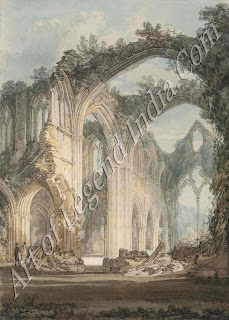
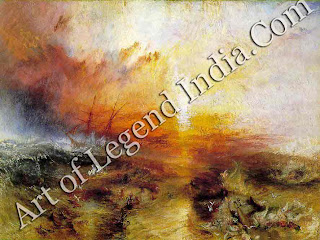
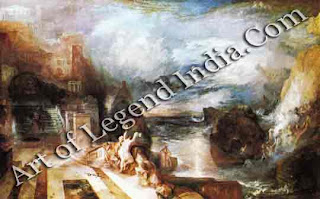










0 Response to "British Great Artist Josep Turner - The Drama of Nature "
Post a Comment